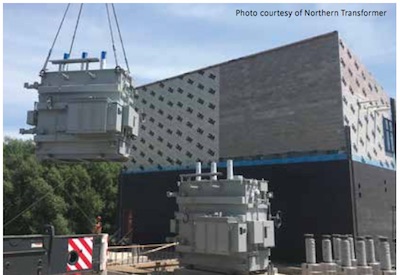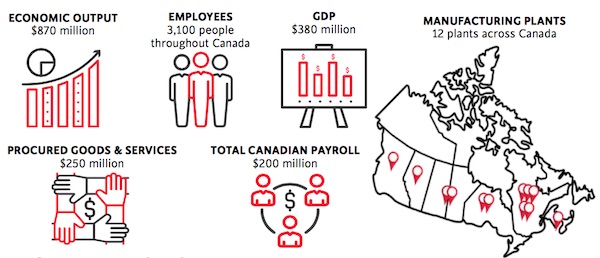The Canadian Transformer Industry: A Strong Record of Leadership

Nov 27, 2018
The Transformer industry is a vital component of our electrical system. Transformers allow the efficient transmission and distribution of power across grids, providing society with safe and reliable access to electricity. The Canadian Transformer industry is a large and growing market, contributing 36% of Canada’s total electrical manufacturing revenue.[1]
Electro-Federation Canada (EFC) represents leading electrical manufacturers that design, manufacture and market Power, Distribution and Dry-type Transformers, among other electrical equipment, for Canadian and global markets. EFC’s Transformer members contribute significantly to the overall Canadian economy.
In 2017, members in this industry segment contributed the following.

Industry outlook
With customer demand for electricity on a steady rise, investments in new energy and infrastructure projects are required to renew Canada’s aging infrastructure to enable efficient power transmission.
According to the Canadian Electricity Association (CEA), worldwide revenue from residential demand response is expected to grow from $322 million in 2014 to $2.3 billion in 2023. On a provincial level, Ontario is aiming to use demand response to meet 10% of its peak demand by 2025, equivalent to approximately 2,400 megawatts under forecast conditions. CEA also forecasts capital expenditures in new electrical infrastructures, including transformers, to exceed $350 billion over the next 20 years, and total North American expenditures are forecasted at 10 times that amount.[2]
While this investment is a positive step forward, continued stakeholder engagement and commitment is necessary if we are to preserve and advance Canada’s interests in a sustainable and local transformer industry — a critical pillar for a secure and reliable electricity grid and strengthening Canada’s economy.
The Canadian transformer industry: a strong record of leadership
Transformers are a vital part of all electrical systems — they allow the transmission of electricity over long distances and transform energy into useable voltage levels for all parts of our economy. Virtually all electricity that is consumed passes through multiple transformers on its way to users.
Canada has a long history of innovation and leadership in the transformer market. Our expertise in the engineering and design of reliable, secure transformers that have supported electrical grids for decades, to developing employment opportunities for skilled trades in electrical wiring, high voltage testing, machining, welding, coil winding and insulation systems — has advanced not only the overall Canadian electrical system but has drawn worldwide acclaim. Canada is widely recognized for its transformer expertise. In fact, Canada designed and manufactured the world’s first 735kV and 765kV power transformers.
This leadership has resulted in strong economic output by the industry. Today, transformer manufacturers contribute substantially to Canada’s GDP, procured goods and services, capital and research investments, and employment. Moving forward, this market is positioned for growth, due to the need to replace aging infrastructure and the need to meet growing demand for new electricity generation in all regions across Canada.
Returning value to Canada: growth opportunities
Today, across North America, most installed transformers are approaching, and even exceeding, the end of their useful 25-to-40-year service life. In fact, it is not unusual to find transformers that were installed 50-70 years ago. While numerous “life extension” programs have been employed over the past two decades, the reality remains that this critical infrastructure needs renewal to ensure that we continue to benefit from a secure and reliable supply of electricity. In Canada alone, required capital expenditures in new electrical infrastructures, including transformers, are forecasted to exceed $350 billion over the next 20 years and total North American expenditures are forecasted at 10 times that amount.[3]
“Investing in infrastructure renewal is crucial for modernizing the electrical grid and meeting the evolving energy needs of Canadians today — and for future generations to come,” said Channa S. Perera, Vice President, Policy Development, CEA. “Successfully meeting this challenge would require sustainable, cost-effective, and innovative technology solutions.”
An integral part of the Canadian electrical community, transformer manufacturers have already started developing smart, more energy-efficient and flexible transmission and distribution equipment that meets current and impending regulations in both Canada and the United States.[4] This change will bring about significant energy and cost savings, and will help reduce greenhouse gas emissions and lower overall environmental impacts.
Barriers to success
As promising as this outlook is, the Canadian transformer industry and related suppliers face several challenges that require stakeholder attention. The barriers that require immediate attention include:
• tariffs. It is critical for the electrical industry to have continued access to raw materials at competitive prices to support Canada’s strategic interest to supply this critical infrastructure. The imposed tariffs pose a great threat to transformer manufacturers’ ability to produce home-grown, secure and reliable electrical transmission and distribution equipment for the grid.
• offshore competition. While fair international competition and their related imports are an important element of a healthy competitive landscape, certain external competitors continue to receive significant domestic support in their home markets and dump transformers into the Canadian market (e.g., as evidenced by the Korean dumping case). This unfair trading practice jeopardizes our access to a reliable stream of competitively-priced equipment and harms Canadian producers by putting them (and the Canadians that they employ) at significant financial risk, thereby also impacting our nation’s overall economic prosperity.
• talent gap. Investment assistance in securing the next generation of talent is required to help the industry attract and retain skilled employees to replace an aging workforce.
Call to action
Meeting the challenges will require strong action on several fronts:
• trade. Governments need to continue being vigilant towards unfair trade practices and supportive of the industry’s anti-dumping efforts.
• procurement policies. It is imperative to be open to innovative procurement policies considering the extent of time before new opportunities for any transformer re-investment occurs. Transformers operate very efficiently and have life expectancies that exceed 25-40 years and more. Unlike other sectors, the window for new replacement opportunities do not reoccur for at least another 25-40 years and are essentially lost during this lifetime. As well, Canadian utilities and other users of transformers can also support the industry through innovative procurement policies that recognize the longevity of these transformers and the importance of building local ecosystem, expertise, supply chain, values and innovations.
• research development. Publicly funded research and commercialization programs are essential to support the continued product and technology leadership.
• talent initiatives. The talent deficit needs to be filled through collaborative action among government, industry and educational institutions. Training, scholarship programs (e.g., EFC’s Scholarship Program), mentoring programs and employment incentives can serve to reverse the deficit — and grow high-value jobs and economic activity in Canada. Talent retention strategies are also necessary to help ensure we keep the skills, knowledge and expertise within our borders.
The strategic importance of having an “engineered and manufactured in Canada” solution for electrical utilities and large industrials is evident. Without it, we risk jeopardizing our country’s expansion and electrical infrastructure regeneration. Given the vital nature of transformers to the daily lives of Canadians, having a healthy local industry represents a matter of national security. As well, the transformer industry and its domestic supply chain provide numerous direct and indirect economic benefits to our nation.
With good prospects for the industry’s growth, the challenge is not only to expand investment, but to extend support — so this home-grown industry can capitalize on emerging opportunities to provide safe, reliable electrical transformation and continue to bring strong economic benefits and social advantages, while ensuring energy supply security for all Canadians.
This article was first published online by Electro-Federation Canada. EFC’s Transformer Section comprises Canadian manufacturers of all dry-type transformers, liquid-filled distribution transformers, power transformers and current or voltage instrument transformers of various classes. For more information, visit www.electrofed.com/products.
Endnotes
1. The Canadian electrical manufacturing industry generates $4.5 billion in total revenue.
The Transformer market accounts for 36.4% of this total revenue (Source: IBIS World. Electrical Equipment Manufacturing in Canada, September 2016)
2. Canadian Electricity Association (CEA), Electric Utility Innovation: Toward Vision 2050, 2015: https:/cea-ksiu6qbsd.netdna-ssl.com/wp-content/uploads/2017/05/ElectricUtilityInnovation-2.pdf
3. Ibid
4. http:/www.nrcan.gc.ca/energy/regulations-codes-standards/18318











